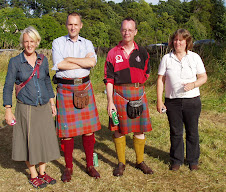Non-knit
Here’s a
question for you.
We were
weary last night after a hospital appt for my husband to have his right hand
scanned for rheumatic trouble. All went well, appt kept promptly, we were back
for a late lunch before he succumbed to a low-blood-sugar episode – but this
sort of thing takes its toll of us old folks, and in the evening we were fit
for nothing more than Gregory Peck v. the Apache Nation.
And my
question is this: is the convention that one mounts a horse from the left, a
universal constant in the relation of man and beast? Or just a European notion?
What did they do in the mountains of Peru
or on the steppes of Tibet Hollywood
Knitting
On I went,
with my knitting belt. I had two single-colour rounds yesterday. Speed was up
to a slow trot, to continue the equine theme.
I noticed
that my right hand was briefly aiming the rigid needle for its entry into the
stitch, before nipping up to throw the yarn. I had another look at the Harlot’s
video – is that what her right hand does? No. Her fingers are completely free
of any other task than throwing the yarn, but part of her right hand – what do
you call it? the bit between the wrist and the point where the thumb bone is
connected to the hand bone? – is pressed against the needle.
By the time
I found that out, I was back to a two-colour passage and couldn’t make it work
at all.
I’ll
struggle on, but so far there is not the slightest pleasure in this.
But, ah!
the Milano! Thank goodness for the Milano! There’s much to be said for
love-at-first-sight and impulse-buying.
All the
colours are now employed, and I have started back up the row with two-round and
eight-round stripes transposed. Perhaps you can just see, on the right-hand part of the circular needle, the start of an eight-round stripe in Aqua which is the two-round stripe with which the story begins.
I’m going to have to think about shape pretty
promptly. It wouldn’t be a bad idea to do it today. If I’m going to knit this
as Relax3, I will need underarm increases for the dolman sleeves. Milano, as
written, has underarm decreases for what might loosely be termed set-in
sleeves, although the joining line comes halfway between shoulder and elbow.
I think I
incline towards the Relax shaping, since it has worked well for me twice. But
I’ll have to think about it. I really dislike thinking.





I know nothing at all about riding horses (have only ever been on the back of a very large police grey) but it occurs to me that the vast majority of humans are right handed and presumably right footed as well. That being the case is the mount from the left due to the fact that the right leg (and presumably arm) would do most of the work? If that is so then it would suggest that the mount from the left is likely to be universal. (It's just a theory. I may be totally wrong.)
ReplyDeleteI have been told that back in the days of the Knights they mounted from the left to protect the horse from the sword they wore on their right leg.
ReplyDeleteNow horses are often trained to be mounted from either side.
Left hand traffic and curbside steps as well as buckle location on the left of bridles and saddles have surely something to do with the fact that people mount horses from the left. I'm sure that in free style riding without modern bridles people would have mounted any which way. As children we used any handy fence or lump of grass and didn't mind which way the pony was facing if that's anything to go by. It's only when adults start talking about the 'wrong side' that you're forced into submission. But like I said considering that you have to check the saddle buckle and bridle straps before you mount it makes perfect sense to stay on the left to mount as well. Once you do that a few times muscle memory takes over and it becomes quite an undertaking to try and mount a horse from the right. But my hunch is your guess is right, Jean, there must have been people who mounted from the right. The next question is: did their whole tribe or village mount from the right too, because everyone learnt from their elders and they must have had muscle memory too?
ReplyDeleteMilano is looking great!
ReplyDeleteBeverly in NJ
Back in the day in Europe a knight always wore his sword on his left side so he could draw it with his right hand. No one was allowed to be left handed at the time, sign of the devil or some such. When you have a large heavy object hanging off your left side it would be very hard to swing that leg over your horse, not to mention possibly quite dangerous for both knight and horse. So all horses were mounted from the left. This is fine if you're always mounting your horse in, if you will, controled circumstances - a flat field for example; with of course a bunch of squires to help boost a heavily armored knight into the saddle. Mouting from the left has now become a tradition in many riding schools.
ReplyDeleteI'm not familliar with the Appache techniques but, since they didn't use swords for one thing, they almost certainly trained their horses to be mounted from all directions, possibly including a leap over the rump by the rider (you can imaging the boys doing this trick would have to aim pretty carefully.....) because they would be mouting their horses in all kinds of different situations. On narrow trails next to a sharp drop off for example. The lands they lived in were quite rugged in places.
Today there is no reason not to train your horse to be mounted from either side. In fact I'd recomend it if you do any trail riding as you can never be sure exactly what you'll find on the trail and you don't want your horse panicing because you're trying to mount from the wrong side. Most riders find it easier to mount from the left, 90% of people being right handed and all, but it's a good idea to at least know how to mount from the right. And to be sure your horse won't buck you off if you try.
An interesting conundrum. Perhaps I will post it to the Completely Pointless and Arbitrary Group on Ravelry to find out from the more horsey of us if they know.
ReplyDeleteMary mom, I think the sword hangs from the left so as to draw with the right. It would be cumbersome too for a knight or other to mount on the right with this long thing hanging along your left side.
Oddly enough I too was wondering quite recently about the "mount from the left" custom. I came independently to Cat's conclusion that it has to do with being the easier or more natural sequence of motions for right-handed people, but I'd like to know what the custom is in central Asia, where horses were first domesticated. And how did people mount horses before the invention of the stirrup, anyway?
ReplyDelete-- stashdragon
but what about bikes (bicycles)? in the Netherlands i rode and mounted my bike all the time, now i live in the USA and walk, and i have to think how i did it.
ReplyDeleteFrom the left is my first thought - standing on the left leg, swinging the right one over it (well a lady's bike does not have a high bar), and then taking off.
else
I was lucky and took Stephanie Pearl-McPhee's class on lever knitting just a few weeks ago. Your observations are spot on - the right needle is still, held in place by a gentle pressure towards the body with the fleshy part of the hand between the thumb and the wrist. Another key part: the yarn is tensioned around the third and fourth fingers of the right hand, leaving the thumb and index fingers free for other purposes. The motion of the yarn is less a wrapping around the needle and more of a flicking movement. The fingers of the left hand move the unworked stitches toward the end of the needle.
ReplyDeleteAnother point she stressed: power-loading the left needle before starting the row by pushing the stitches together towards the right, so that they tend to pop off the needle more readily after being worked.
A fascinating fact about this method: unlike any other knitting method I have used (and I took Annie Modesitt's class, too), knit and purl stitches are given essentially the same treatment. The only difference is where the right hand needle goes into the stitch. Other than that, the motion of the right hand flicking the yarn around the needle is the same for both stitches.
I'm finding that my tension is tighter, but that appears to be mainly an effect of the technique being new to me. Now that I've been practicing for a couple of weeks, my tension is starting to relax into something that feels more natural to me. Even as a rank beginner with this style, my knitting is noticeably more uniform, and the edges of my k2 p2 ribbing are beautiful. I may have found what will become my preferred knitting style.
The mounting on the left thing is now just a tradition. My cousins and I were wild riders in that we never had a formal lesson, wore the accepted clothes or even the hard hat, and didn't comply to the norms of riding. We just used our ponies as intelligent bikes, riding where we liked on my uncle's farm as soon as we were school age. Apart from a couple of startled looks from ponies that had been properly schooled, none of us had any problems regardless of how we mounted, or fell out of a tree or haystack onto our mounts.
ReplyDeleteTo me it makes sense for British riders to mount or dismount on the left of the horse because that puts the unmounted person on the road side, not in the middle of oncoming traffic, but I can't see any point in keeping an archaic practice going elsewhere. When I was at college I earned money by being a weekend groom for a famous show jumper and delighted in mounting on the 'wrong' side just to see the gasps of horror from the well heeled horsey brigade! People can be so precious sometimes..... but then, having taught myself to knit when young, you might well gasp with horror as to how I cast on....!
Beautiful colors
ReplyDelete